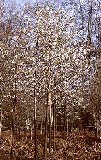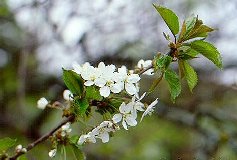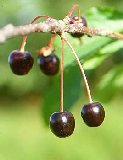Cherry Flower
http://www.100md.com
《e Natural Health Center》
 |
 |
 |
 |
Flowers, Tea
Cherry Flower
Latin:
Flos Prunus avium
Origin:
Cherry refers to any of various trees belonging to species of Prunus and their edible fruits, of the family Rosaceae. Most cherry species are native to western Asia and eastern Europe, from the Caspian Sea to the Balkans, where they are widely grown. Cherries had spread throughout Europe, however, before agricultural history was recorded. Some 10 to 12 species are recognized in North America and a similar number in Europe. The greatest concentration of species, however, appears to be in eastern Asia.
, http://www.100md.com
Cherries are grown in all areas of the world where winter temperatures are not too severe and where summer temperatures are moderate. We can thank cherry-loving birds for the widespread distribution of the trees. They require winter cold in order to blossom in spring. The trees bloom quite early in the spring, just after peaches and earlier than apples.
Three types of cherry are mainly grown for their fruit. These are the sweet or wild cherries, Prunus avium L.; the sour, or tart, cherries, Prunus cerasus L.; and, grown to a much smaller extent, the duke cherries, Prunus x gondouinii (Poit.& Turpin.) Schneid., which are crosses of sweet and sour cherries.
, 百拇医药
Sweet-cherry trees are large and rather upright, attaining heights up to 18 m and about 7 m wide. It is in flower from April to May, and the seeds ripen from July to August. Cherry trees are recognized by their lovely white blossoms in early spring. The flowers foretell the end of winter, and so symbolize rebirth, youth, and innocence in countries such as China and Japan. The flowers are hermaphrodite (have both male and female organs) and are pollinated by bees. The tree can grow in semi-shade (light woodland) or no shade. It requires moist soil.
, 百拇医药
Sweet cherry fruit is generally heart-shaped to nearly globular, about 2 cm in diameter and contains one large seed. The acid content of the sweet cherry is low. The fruit varies in color, including the deep-burgundy colored Bing, Lambert, and Tartarian, common in the United States, and the yellow varieties, usually blushed with red, called Royal Ann, Rainier, or Napoleon. Royal Ann cherries are the ones specially processed, dyed red, and sold as maraschino cherries. Other sweet cherry varieties include the Bigaroon and Gean.
, 百拇医药
The higher acid content of the sour cherry produces its characteristic tart flavor. Sour-cherry trees are smaller, rarely over 5 m in height. The fruit is round to oblate in shape, generally dark red in color, and it has so much acid that it is not appealing for eating fresh. Sour varieties, favored for use in pies and preserves, include the brilliant red Montmorency and the smaller Morello.
The duke cherries are intermediate in both tree and fruit characteristics.
, 百拇医药
The U.S. is the leading cherry producer, with an annual crop of 230,000 metric tons. Cherries are a major crop in western Europe, however; total production is about 700,000 tons annually, with Germany, Italy, France, and Switzerland the leaders. Turkey, Japan, Argentina, Chile, Australia, and Canada also produce substantial quantities.
About three-quarters of the U.S. production is sour cherries, which are frozen or canned and used in sauces and pastries, notably cherry pie. Sweet cherries, in season, are consumed fresh and widely canned and are the principal type preserved in true or imitation maraschino liquor. In Europe the fruit is used fresh, canned, or for wine.
, 百拇医药
The wood of a number of cherry species is close grained, dark red in color, and especially esteemed for the manufacture of fine furniture.
In the Orient, particularly Japan, cherry varieties have been selected for the beauty of their flowers; most of them do not set fruit. These beautiful ornamentals are featured in many gardens and after about 1900 were widely disseminated throughout the moderate-temperature areas of North America and Europe. The Japanese flowering cherries around the Tidal Basin in Washington, D.C., were presented by the mayor of Tokyo in 1912.
, http://www.100md.com
See also Food, Fruits, Cherry.
Properties:
Sweet in flavor, warm in nature, it is related to the spleen channel.
Functions:
Benefits qi (energy) and spleen, relieves rheumatism.
Applications:
Cherry is used for paralysis, rheumatism, gout, numbness, frosbite.
, http://www.100md.com
The seed of the cherry fruit is used in traditional Chinese medicine for bursting of measles for children.
Dosage and Administration:
Cherry flowers are decocted as tea for drinking;
cherry leaves are crushed and mixed with liquor for topical application on areas of snake or insect bites.
Cautions on Use:
, 百拇医药
Although no specific mention has been seen for this species, it belongs to a genus where most, if not all members of the genus produce hydrogen cyanide, a poison that gives almonds their characteristic flavor. This toxin is found mainly in the leaves and seed and is readily detected by its bitter taste. It is usually present in too small a quantity to do any harm but any very bitter seed or fruit should not be eaten. In small quantities, hydrogen cyanide has been shown to stimulate respiration and improve digestion, it is also claimed to be of benefit in the treatment of cancer. In excess, however, it can cause respiratory failure and even death.
, http://www.100md.com
Reference Materials:
Toxic or Side Effects:
Modern Researches:
The fruits of all varieties of cherry provide vitamin A and small amounts of such minerals as calcium and phosphorus. It also contains about 78 percent water, 8.5-14 percent sugars.
The fruit stalks are astringent, diuretic and tonic. A decoction is used in the treatment of cystitis (inflammation of the urinary bladder), oedema, bronchial complaints, looseness of the bowels and anaemia (too few red blood cells in the bloodstream).
, 百拇医药
An aromatic resin can be obtained by making small incisions in the trunk. This has been used as an inhalant in the treatment of persistent coughs.
According to a 1950 study of 12 people with gout, eating about 227 g of cherries or drinking an equivalent amount of cherry juice prevented attacks of gout. Black, sweet yellow, and red sour cherries were all effective. Since that study, there have been many anecdotal reports of cherry juice as an effective treatment for the pain and inflammation of gout. The active ingredient in cherry juice remains unknown.
, 百拇医药
A green dye can be obtained from the leaves.
A dark grey to green dye can be obtained from the fruit.
The bark usually only contains small amounts of tannin, but this sometimes rises to 16 percent.
The wood of cherry tree is reddish brown in color. It is firm, compact, with satiny grain; and is used for turnery, furniture, veneers, decorative panelling and instruments. It is also good firewood with fragrance of blossom as it burns., 百拇医药